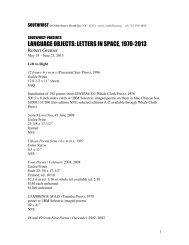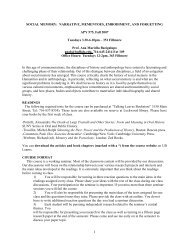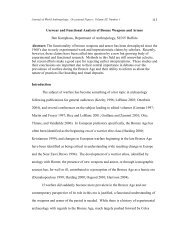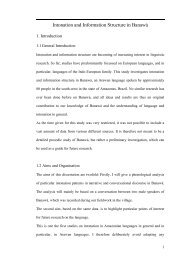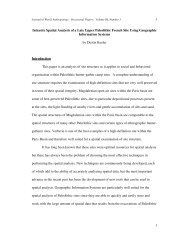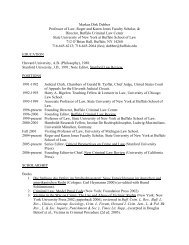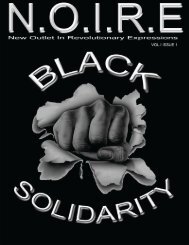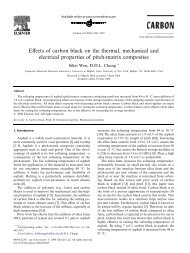Mandolin Mania in Buffalo's Italian Community, 1895 to - Wings ...
Mandolin Mania in Buffalo's Italian Community, 1895 to - Wings ...
Mandolin Mania in Buffalo's Italian Community, 1895 to - Wings ...
Create successful ePaper yourself
Turn your PDF publications into a flip-book with our unique Google optimized e-Paper software.
Journal of World Anthropology: Occasional Papers: Volume II, Number 2 1<br />
<strong>Mandol<strong>in</strong></strong> <strong>Mania</strong> <strong>in</strong> Buffalo’s <strong>Italian</strong> <strong>Community</strong>, <strong>1895</strong> <strong>to</strong> 1918<br />
Jean Dickson<br />
University at Buffalo (SUNY)<br />
The Estudiant<strong>in</strong>a Figueroa, or so-called “Spanish Students” troupe landed <strong>in</strong> New York <strong>in</strong><br />
1880 with bandurrias, exotic costumes and thrill<strong>in</strong>g music, <strong>to</strong> receive an enthusiastic welcome.<br />
The response was immediate and predictable – they were copied.<br />
Their imita<strong>to</strong>rs, a group of <strong>Italian</strong> immigrants led by Carlo Curti, played mandol<strong>in</strong>s<br />
<strong>in</strong>stead of bandurrias, spark<strong>in</strong>g a new musical enthusiasm <strong>in</strong> North America. They called them-<br />
selves the “Orig<strong>in</strong>al Spanish Students” and <strong>to</strong>ured the country for several years, enterta<strong>in</strong><strong>in</strong>g<br />
people <strong>in</strong> <strong>to</strong>wns and cities far from New York City. Eventually, many of them settled down as<br />
music teachers and performers all around North America.<br />
Carlo (or Carlos) Curti was a viol<strong>in</strong>ist who had come <strong>to</strong> New York <strong>in</strong> 1876 as a member<br />
of a French orchestra. He later claimed responsibility for organiz<strong>in</strong>g the fake “Spanish student”<br />
troupe and another, more openly <strong>Italian</strong>, organization called the “Roman Students” (The Cadenza<br />
1909). He eventually settled <strong>in</strong> Mexico City, where he taught mandol<strong>in</strong>, wrote operettas and<br />
a comic opera, and directed the orchestra at the Orr<strong>in</strong> theater, before return<strong>in</strong>g <strong>to</strong> New York <strong>in</strong><br />
1902 (The Cadenza 1902).<br />
He also composed music for mandol<strong>in</strong> orchestras, often <strong>in</strong> a Spanish or Mexican style.<br />
One of his best known works was “Flor de Mexico” or “Flower of Mexico” (Fig. 1) (Curti<br />
1903:46-47).<br />
<strong>Mandol<strong>in</strong></strong>s had several advantages for a country like the US <strong>in</strong> the 19th and early 20th<br />
century, where people were often on the move. <strong>Mandol<strong>in</strong></strong>s were portable, relatively easy <strong>to</strong> learn<br />
<strong>to</strong> play at least on a beg<strong>in</strong>ner level, the sound carried well, and they could be used <strong>to</strong> play a wide<br />
range of musical styles. The mandol<strong>in</strong> carried an image of European culture and sophistication,<br />
and this was welcome especially <strong>in</strong> the many relatively isolated <strong>to</strong>wns and cities <strong>in</strong> North Ameri-<br />
ca where people were hungry for culture and enterta<strong>in</strong>ment.
Journal of World Anthropology: Occasional Papers: Volume II, Number 2 2<br />
Tig. 1: The Flower of Mexico (Curti 1903).<br />
Besides Carlo Curti there were many other <strong>Italian</strong> immigrants who were very <strong>in</strong>fl uential<br />
<strong>in</strong> spread<strong>in</strong>g the mandol<strong>in</strong>-play<strong>in</strong>g enthusiasm across the USA. The most prom<strong>in</strong>ent was Gi-<br />
useppe Pett<strong>in</strong>e, who arrived <strong>in</strong> Providence, Rhode Island, from Isernia, Italy, a virtuoso perform-<br />
er, composer, and nationally known teacher of mandol<strong>in</strong> technique. He is credited with promot-<br />
<strong>in</strong>g the “duo style” of mandol<strong>in</strong> play<strong>in</strong>g, <strong>in</strong> which one player plays both the rhythmic chords and<br />
the lyric melodic l<strong>in</strong>e at once, comb<strong>in</strong><strong>in</strong>g s<strong>in</strong>gle strokes and tremolo.<br />
Other <strong>Italian</strong> virtuosos who made names for themselves play<strong>in</strong>g mandol<strong>in</strong> <strong>in</strong> the USA<br />
(primarily on the East Coast) <strong>in</strong>cluded Stellario Cambria and V<strong>in</strong>cenzo Carli, both of whom also<br />
settled <strong>in</strong> Providence.
Journal of World Anthropology: Occasional Papers: Volume II, Number 2 3<br />
Buffalo <strong>in</strong> the late 19th and early 20th century was a thriv<strong>in</strong>g <strong>in</strong>dustrial and trade city,<br />
and had already built a strong musical foundation and a progressive record <strong>in</strong> public education.<br />
Throughout the 19th century the city experienced waves of immigration, mostly English, Ger-<br />
mans and Irish until the last two decades, when <strong>Italian</strong>s and Poles came <strong>in</strong> large numbers.<br />
By the time <strong>Italian</strong> immigrants began <strong>to</strong> arrive <strong>in</strong> large numbers, the city was run primar-<br />
ily by the “American” (English orig<strong>in</strong>) Protestants and the Germans, who were mostly Catholics<br />
(although a few were Jews or Protestants), with Irish fi ll<strong>in</strong>g the lower middle-class positions <strong>in</strong><br />
society. <strong>Italian</strong>s and Poles had <strong>to</strong> enter at a lower social rung. Many young <strong>Italian</strong> immigrant<br />
men graduated from the local colleges and entered the ranks of at<strong>to</strong>rneys, pharmacists and physi-<br />
cians, while educated young <strong>Italian</strong> women became teachers, pharmacists and nurses; other Ital-<br />
ian men became successful <strong>in</strong> civil service or political positions. The majority worked <strong>in</strong> manual<br />
labor and skilled labor jobs, as railroad workers, street peddlars, s<strong>to</strong>nemasons, carpenters, and<br />
farm laborers. Many founded small bus<strong>in</strong>esses, such as barbershops, groceries, shoe s<strong>to</strong>res, etc.,<br />
while a few became relatively wealthy and built manufactur<strong>in</strong>g plants, usually produc<strong>in</strong>g food<br />
products for the <strong>Italian</strong> immigrant market.<br />
While Buffalo attracted <strong>Italian</strong> immigrants from all over Italy, the Sicilians were the most<br />
numerous. Thanks <strong>to</strong> local <strong>Italian</strong> newspaper edi<strong>to</strong>r, amateur his<strong>to</strong>rian, and author Ferd<strong>in</strong>and<br />
Magnani, we have some <strong>in</strong>terest<strong>in</strong>g facts on this period. Magnani wrote a short book, published<br />
<strong>in</strong> 1908, on the many attractions of Buffalo, entitled La città di Buffalo e d<strong>in</strong><strong>to</strong>rni e le colonie<br />
italiane, <strong>in</strong>tended <strong>to</strong> draw more <strong>Italian</strong>s <strong>to</strong> the city.<br />
<strong>Mandol<strong>in</strong></strong> clubs and ensembles <strong>in</strong> Buffalo<br />
Musical activity was woven <strong>in</strong><strong>to</strong> Buffalo’s educational system. In the 1890s Buffalo’s<br />
high schools and colleges already had student clubs devoted <strong>to</strong> mandol<strong>in</strong>, guitar and banjo. The<br />
students paid music teachers <strong>to</strong> <strong>in</strong>struct and direct the clubs; along with the college glee clubs,<br />
the mandol<strong>in</strong> clubs performed for alumni and prospective students, act<strong>in</strong>g as ambassadors for<br />
their schools. S<strong>in</strong>ce the average person only attended school up <strong>to</strong> the required age of 12 years,
Journal of World Anthropology: Occasional Papers: Volume II, Number 2 4<br />
high schools and colleges only <strong>to</strong>ok <strong>in</strong> professionally oriented youth dur<strong>in</strong>g this period. Partici-<br />
pation <strong>in</strong> these mandol<strong>in</strong> clubs was seen as a refi nement suitable for young people of both gen-<br />
ders.<br />
Lafayette High School <strong>in</strong> particular had a thriv<strong>in</strong>g musical environment; the mandol<strong>in</strong><br />
clubs <strong>in</strong>cluded both girls and boys, from 1898 <strong>to</strong> 1910. The mandol<strong>in</strong> and guitar clubs played<br />
ragtime, marches, two-steps, and other popular music (Oracle 1912).<br />
Besides the school- and college-based clubs, there were similar clubs <strong>in</strong> settlement houses<br />
and <strong>in</strong> the YMCA. These organizations aimed at assimilation and <strong>in</strong>tegration of the immigrants,<br />
offer<strong>in</strong>g free English-language classes, and sometimes music lessons. Instrumental music was<br />
seen by the elite as another means of uplift<strong>in</strong>g the masses.<br />
Musical ferment <strong>in</strong> the grow<strong>in</strong>g and highly concentrated <strong>Italian</strong> community of Buffalo,<br />
however, bubbled over <strong>in</strong><strong>to</strong> the entire city. Some immigrants <strong>to</strong> Buffalo were conserva<strong>to</strong>ry<br />
tra<strong>in</strong>ed musicians (among them Nicola Donadio, Dante Barozzi, and Pietro Licari), while others<br />
were less formally tra<strong>in</strong>ed yet very talented performers (for example, Isidoro Term<strong>in</strong>i and Ignacio<br />
Millonzi).<br />
In the Pan American Exposition of 1901, one of the most attractive Midway venues was<br />
called “Venice <strong>in</strong> America,” which featured temporary canals with gondolas and mandol<strong>in</strong>ists<br />
and guitarists who serenaded the visi<strong>to</strong>rs. Some of the musicians were hired <strong>in</strong> Italy and brought<br />
Fig. 2: Intalian mandol<strong>in</strong>ists at the Pan American Exposition, Buffalo, 1901 (Arnold 1901)
Journal of World Anthropology: Occasional Papers: Volume II, Number 2 5<br />
<strong>to</strong> Buffalo for the 1901 summer season, while others were hired <strong>in</strong> the <strong>Italian</strong> Colonia (settle-<br />
ment) of Buffalo (Fig. 2).<br />
Although I have identifi ed several of these musicians, for <strong>in</strong>stance, Joseph Leone, Gi-<br />
useppe and Salva<strong>to</strong>re Or<strong>to</strong>lani, Luigi Loman<strong>to</strong>, Ciro Laduca, Giuseppe Sagone, An<strong>to</strong>n<strong>in</strong>o<br />
Gug<strong>in</strong>o, Giuseppe Vacanti, and Liborio Maggio, all of whom, except for Leone, were cited <strong>in</strong><br />
the Corriere <strong>Italian</strong>o, I cannot connect the names <strong>to</strong> <strong>in</strong>dividuals <strong>in</strong> the contemporary pho<strong>to</strong>graphs<br />
(Arnold 1901).<br />
Judg<strong>in</strong>g from contemporary report<strong>in</strong>g on the <strong>Italian</strong> music scene <strong>in</strong> Buffalo <strong>in</strong> the Corri-<br />
ere, the <strong>Italian</strong> mandol<strong>in</strong>ists and guitarists were apparently all male, while several young women<br />
Fig. 3: Obera S<strong>in</strong>gers: Carbone Sisters, 1905 (Corriere <strong>Italian</strong>o 1905)<br />
made musical careers as vocalists. The most notable were N<strong>in</strong>a Morgana, Grazia Carbone, and<br />
her sister Carmela Carbone (Fig. 3).<br />
The <strong>Italian</strong> march<strong>in</strong>g bands were very visible from about 1890 <strong>to</strong> the 1930s, especially<br />
down<strong>to</strong>wn, where they marched <strong>in</strong> religious festivals, serenad<strong>in</strong>g residents and parad<strong>in</strong>g the ma<strong>in</strong><br />
streets. The same bands – especially the famous Sc<strong>in</strong>ta Band, founded by Serafi no Sc<strong>in</strong>ta <strong>in</strong> the
Journal of World Anthropology: Occasional Papers: Volume II, Number 2 6<br />
late 1880s (Magnani 1908:35) -- played summer concerts at Buffalo’s parks, compet<strong>in</strong>g with the<br />
Germania band and the two US Regimental bands stationed <strong>in</strong> Buffalo, the 74th and 65th Regi-<br />
mental bands, for paid performances. The Sc<strong>in</strong>ta band was extremely popular, and played at the<br />
Pan American Exposition <strong>in</strong> 1901 and later spent a couple summers play<strong>in</strong>g at Coney Island.<br />
The men who played clar<strong>in</strong>et, trombone, tuba, drums, saxophone, or another <strong>in</strong>strument<br />
<strong>in</strong> these concert bands and march<strong>in</strong>g bands often played mandol<strong>in</strong>, viol<strong>in</strong>, or guitar <strong>in</strong> smaller<br />
dance bands and chamber ensembles. These str<strong>in</strong>g ensembles played at church services, at hotels<br />
and restaurants, at benefi ts, and at private parties <strong>in</strong> the <strong>Italian</strong> “Colonia” <strong>to</strong> celebrate marriages,<br />
baptisms, anniversaries, and other family and social events.<br />
<strong>Italian</strong>s and <strong>Italian</strong>-Americans also performed <strong>in</strong> the ma<strong>in</strong>stream (English-language) the-<br />
atres, <strong>in</strong> pit orchestras and at movie theatres. In 1906, for example, the Savoy Trio played regu-<br />
larly at the luxurious Genesee Hotel, on the corner of Ma<strong>in</strong> and Genesee Streets. The members<br />
Fig. 4: Term<strong>in</strong>i, Millonzi, and Francesco (The Cadenza 1906).
Journal of World Anthropology: Occasional Papers: Volume II, Number 2 7<br />
of the Trio were Isidoro Term<strong>in</strong>i, Ignacio Millonzi and Tomaso Francesco, also known as Tom<br />
Francis (Fig. 4) (The Cadenza 1906).<br />
Similarly, a young group, apparently still teenagers <strong>in</strong> the Corriere pho<strong>to</strong> <strong>in</strong> 1910, the<br />
Pulv<strong>in</strong>o Brothers, played mandol<strong>in</strong>s and guitars at movie theatres and at Carnival Court, an<br />
amusement park then at the corner of Ma<strong>in</strong> and Jefferson Streets. In 1912 they reportedly played<br />
popular songs and accompanied dances <strong>in</strong> the <strong>Italian</strong> community (“Trattenimen<strong>to</strong>” 1; “Tratteni-<br />
men<strong>to</strong>” 5; “Il Concer<strong>to</strong>” 1).<br />
As the number and density of the <strong>Italian</strong> Colonia rose, the immigrants formed dozens of<br />
mutual aid organizations, mostly centered on their <strong>to</strong>wn of orig<strong>in</strong>, but sometimes on their trade.<br />
Thus there were Società Montemaggiore Belsi<strong>to</strong> and the Società Bagheria, but also associations<br />
of grocers and lawyers. These organizations provided a k<strong>in</strong>d of group health <strong>in</strong>surance as well as<br />
a social outlet. On religious or patriotic holidays they participated <strong>in</strong> parades, and as soon as fall<br />
arrived, they arranged dances and banquets. Some also sponsored theatrical and musical perfor-<br />
mances.<br />
New musical groups and comb<strong>in</strong>ations arose frequently <strong>in</strong> the <strong>Italian</strong> settlement. Young<br />
<strong>Italian</strong> Americans organized themselves <strong>in</strong> theatrical and musical clubs and performed for their<br />
peers, <strong>in</strong>clud<strong>in</strong>g the Club Aurora, the Filodrammatici, the Circolo Musicale Bell<strong>in</strong>i, the Circolo<br />
Savoia and others.<br />
The music they played<br />
The reper<strong>to</strong>ire of mandol<strong>in</strong> orchestras and ensembles refl ected the diverse musical tastes<br />
of the day. Almost all were <strong>in</strong>strumental works; few <strong>in</strong>cluded vocals. Some of the pieces, like<br />
“A Day <strong>in</strong> the Cot<strong>to</strong>n Field,” were orig<strong>in</strong>ally written for the blackface m<strong>in</strong>strel groups such as<br />
the Christy M<strong>in</strong>strels (founded by George Christy, a Buffalo Irish immigrant). Patriotic songs,<br />
college songs, and marches were popular, while other popular mandol<strong>in</strong> works orig<strong>in</strong>ally written<br />
for viol<strong>in</strong> and conventional str<strong>in</strong>g orchestra.
Journal of World Anthropology: Occasional Papers: Volume II, Number 2 8<br />
Composers of the time, <strong>in</strong>clud<strong>in</strong>g a few <strong>in</strong> Buffalo, also wrote music specifi cally for man-<br />
dol<strong>in</strong> orchestras, as the ensembles were then called.<br />
In the early 1900s, ragtime music, usually played on the piano, was popular with young<br />
people, and this was adapted <strong>to</strong> mandol<strong>in</strong>. Opera excerpts, especially overtures, were also very<br />
popular as mandol<strong>in</strong> orchestra selections. In the <strong>Italian</strong> community, of course, Verdi, Ross<strong>in</strong>i,<br />
Donizetti, and other <strong>Italian</strong> composers were highly favored.<br />
For example, the Corriere reported the follow<strong>in</strong>g performance <strong>in</strong> the entr’actes of “I due<br />
Sergenti” (“The Two Sergeants”): “Un bravo di cuore va da<strong>to</strong> ai valenti mandol<strong>in</strong>isti e chitarris-<br />
ti che deliziarono gli astante con scelti pezzi musicali.” (translation: Hearty applause was given<br />
<strong>to</strong> the talented mandol<strong>in</strong>ists and guitarists who delighted those who attended with select musical<br />
pieces.) Then the article lists the fi rst quartet; G. Puglisi and G. Mammano, on mandol<strong>in</strong>, and<br />
A. Mammano and G. Incao on guitar, played three pieces, <strong>in</strong>clud<strong>in</strong>g one from “Lucia di Lam-<br />
mermoor.” The second quartet, Isidoro Term<strong>in</strong>i and Ignacio Millonzi on mandol<strong>in</strong>, and Carmelo<br />
Peri and Cruciano Millonzi on guitar, played a medley of themes from “Il Trova<strong>to</strong>re” (Il Corriere<br />
<strong>Italian</strong>o 1904).<br />
Fig. 5: Orignanl mandol<strong>in</strong> music published <strong>in</strong> the Corriere <strong>Italian</strong>o (Il Corriere <strong>Italian</strong>o 1904:6).
Journal of World Anthropology: Occasional Papers: Volume II, Number 2 9<br />
Some music, usually American popular songs, was published <strong>in</strong> the Corriere <strong>Italian</strong>o<br />
from 1909 <strong>to</strong> 1910. Both national mandol<strong>in</strong> magaz<strong>in</strong>es, the Crescendo and the Cadenza, pub-<br />
lished music <strong>in</strong> almost every issue (Fig. 5).<br />
The <strong>in</strong>struments they played<br />
US manufacturers began <strong>to</strong> produce mandol<strong>in</strong>s around 1890, when the demand for the<br />
<strong>in</strong>struments was evident, and import<strong>in</strong>g them from Italy was impractical and <strong>to</strong>o expensive for<br />
most would-be players.<br />
Walter Boehm, Buffalo’s Gibson dealer, was important <strong>in</strong> the <strong>in</strong>tegration of <strong>Italian</strong> mu-<br />
sicians <strong>in</strong><strong>to</strong> the ma<strong>in</strong>stream, as well as <strong>in</strong> his role as teacher, publisher, and composer (Fig. 6).<br />
American manufacturers, <strong>in</strong>clud<strong>in</strong>g Gibson, Mart<strong>in</strong>, Stahl, Washburn, and many others, reengi-<br />
neered the Neapolitan mandol<strong>in</strong> and the Spanish guitar, and came up with hybrids, new <strong>in</strong>ven-<br />
Fig. 6: Walter Boehm, musician, composer, Gibson dealer (Boehm 1905).
Journal of World Anthropology: Occasional Papers: Volume II, Number 2 10<br />
tions, and new versions of old <strong>in</strong>struments, <strong>in</strong>clud<strong>in</strong>g the harp guitar, the mando-cello, and the<br />
mando-bass. The mandol<strong>in</strong> underwent transformation, los<strong>in</strong>g its fragile bowl-shaped back, while<br />
ga<strong>in</strong><strong>in</strong>g volume and sharper <strong>to</strong>ne.<br />
What happened <strong>to</strong> these musicians?<br />
Most of the professional musicians who played mandol<strong>in</strong>, guitar, or banjo dur<strong>in</strong>g this<br />
time (<strong>1895</strong> <strong>to</strong> 1918) cobbled <strong>to</strong>gether a liv<strong>in</strong>g by teach<strong>in</strong>g music and direct<strong>in</strong>g clubs. While some<br />
of these musicians moved <strong>in</strong><strong>to</strong> jazz bands and orchestras, many had <strong>to</strong> take <strong>in</strong>dustrial or service<br />
jobs <strong>to</strong> support themselves and their families.<br />
For example, Isidoro Term<strong>in</strong>i (1878-1964) managed <strong>to</strong> make ends meet as a musician,<br />
play<strong>in</strong>g mandol<strong>in</strong>, viol<strong>in</strong>, tuba, or other <strong>in</strong>struments, without rely<strong>in</strong>g on non-musical jobs. He<br />
played <strong>in</strong> the 74th Regimental band, the <strong>Italian</strong> march<strong>in</strong>g band and <strong>in</strong> <strong>in</strong>formal ensembles for<br />
church and family events. In 1904 he had a studio at 136 Erie St., where he taught mandol<strong>in</strong>, vio-<br />
l<strong>in</strong>, and guitar. He cont<strong>in</strong>ued <strong>to</strong> play <strong>in</strong> orchestras of local theatres and then <strong>in</strong> the Philharmonic<br />
Orchestra <strong>in</strong> the 1930s and throughout the rest of his life (Courier Express 1964)<br />
Tom Francis (Tomaso Francesco), a member of the Savoy Trio, bought a popular restau-<br />
rant, the Roma Cafe, <strong>in</strong> 1911, and cont<strong>in</strong>ued <strong>to</strong> play music part-time (Corriere <strong>Italian</strong>o 1911).<br />
The Millonzi brothers traveled a path like Vitale’s. Cruciano returned <strong>to</strong> Italy for good;<br />
Ignacio (1884-1978) went back <strong>to</strong> Italy for a few years and returned <strong>to</strong> Buffalo with his bride and<br />
two more brothers, Rosario and Phillip. Phillip’s son, Robert, was a major benefac<strong>to</strong>r for the<br />
Buffalo Philharmonic. Ignacio cont<strong>in</strong>ued <strong>to</strong> play <strong>Italian</strong> music on the mandol<strong>in</strong>, while he pur-<br />
sued popular dance music (<strong>in</strong>clud<strong>in</strong>g occasional appearances with the Paul Whiteman Band) and<br />
“serious” music on cello. He augmented his <strong>in</strong>come by work<strong>in</strong>g as a tailor and hosted a radio<br />
show play<strong>in</strong>g <strong>Italian</strong> music, both live and recorded, for many years on WEBR (970 AM) (Russo<br />
2005: Personal Communication). In their 80s, both Ignacio and Phillip were still very compe-<br />
tent mandol<strong>in</strong>ists.<br />
Giacomo Vitale, a local guitarist, likewise used his diverse skills, play<strong>in</strong>g woodw<strong>in</strong>ds or<br />
brass <strong>in</strong> dance or jazz bands. Vitale jo<strong>in</strong>ed a <strong>to</strong>ur<strong>in</strong>g dance band <strong>in</strong> the 1920s but soon tired of
Journal of World Anthropology: Occasional Papers: Volume II, Number 2 11<br />
life on the road. In order <strong>to</strong> rema<strong>in</strong> with his family <strong>in</strong> Buffalo, he <strong>to</strong>ok a series of jobs <strong>in</strong> <strong>in</strong>dus-<br />
try, but always considered himself a musician, play<strong>in</strong>g or practic<strong>in</strong>g almost every even<strong>in</strong>g, play-<br />
<strong>in</strong>g at <strong>Italian</strong> church festivals, wedd<strong>in</strong>gs, and parties (Tucker 2005, personal communication).<br />
What happened <strong>to</strong> this music?<br />
The mandol<strong>in</strong> craze did not endure <strong>in</strong> Buffalo, except <strong>in</strong> private parties and ethnically<br />
based concerts <strong>in</strong> the <strong>Italian</strong> community. Nationally, by 1918 it was apparently eclipsed by other<br />
musical trends, especially jazz and the big dance bands. <strong>Mandol<strong>in</strong></strong> sales decl<strong>in</strong>ed. In 1924,<br />
not co<strong>in</strong>cidentally, Gibson <strong>Mandol<strong>in</strong></strong>-Guitar Company became Gibson, Inc. (Gruhn and Carter<br />
1993:85). No longer did the high schools and colleges tra<strong>in</strong> amateur and professional players<br />
<strong>in</strong> school clubs. Only a few remnants of the mandol<strong>in</strong> craze rema<strong>in</strong>ed <strong>in</strong> Buffalo <strong>in</strong> the 1930s,<br />
1940s and beyond: college and high school banjo-mandol<strong>in</strong>-guitar clubs disappeared.<br />
The 1932 direc<strong>to</strong>ry of American Federation of Musicians Local 43 lists 6 professional<br />
mandol<strong>in</strong> players among its members, <strong>in</strong>clud<strong>in</strong>g Phillip Millonzi and Isidore (Isidoro) Term<strong>in</strong>i<br />
(Direc<strong>to</strong>ry of Local 43, AF of M. n.a.). In 1941, the “<strong>Mandol<strong>in</strong></strong> and Guitar Orchestra ‘Harmo-<br />
nie’,” l<strong>in</strong>ked <strong>to</strong> the German-American Harugari social club, is the only mandol<strong>in</strong> organization<br />
listed <strong>in</strong> a Buffalo direc<strong>to</strong>ry of musicians and musical organizations; fi ve teachers of mandol<strong>in</strong><br />
are listed (S<strong>to</strong>eckel’s Music Direc<strong>to</strong>ry 1941:74-5, 122). In the 1947 edition no mandol<strong>in</strong> organi-<br />
zation is listed, but there are still fi ve mandol<strong>in</strong> teachers (S<strong>to</strong>eckel’s Offi cial Direc<strong>to</strong>ry of Music,<br />
Enterta<strong>in</strong>ment, Drama 1947, 47).<br />
Why does this matter?<br />
In the 19th century, many educated people divided music between highbrow and low-<br />
brow. American culture, struggl<strong>in</strong>g over the pa<strong>in</strong>ful legacy of slavery and the confus<strong>in</strong>g results<br />
of mass immigration from Europe, was start<strong>in</strong>g <strong>to</strong> assimilate both <strong>Italian</strong> and African-American<br />
music, as well as the German, Irish, and other European musical heritages. James Reese Europe,
the black New York musical pioneer, turned <strong>to</strong> mandol<strong>in</strong> and piano <strong>to</strong> make a liv<strong>in</strong>g as a musi-<br />
cian <strong>in</strong> New York <strong>in</strong> 1903, and later employed mandol<strong>in</strong>s <strong>in</strong> African American musical theater<br />
Journal of World Anthropology: Occasional Papers: Volume II, Number 2 12<br />
and <strong>in</strong> dance bands until about 1913 (Badger 1995:30, 85), while <strong>Italian</strong> immigrants cont<strong>in</strong>ued <strong>to</strong><br />
dom<strong>in</strong>ate as lead<strong>in</strong>g virtuosos across the United States.<br />
In Buffalo, the mandol<strong>in</strong> was a means of cross<strong>in</strong>g over <strong>in</strong><strong>to</strong> the ma<strong>in</strong>stream both fi nan-<br />
cially and socially, for many <strong>Italian</strong> immigrants, although that cross<strong>in</strong>g was usually only partial,<br />
because the music bus<strong>in</strong>ess was not well enough paid or steady enough <strong>to</strong> ma<strong>in</strong>ta<strong>in</strong> a liv<strong>in</strong>g<br />
wage.<br />
Why did this music decl<strong>in</strong>e?<br />
Material and social changes that might expla<strong>in</strong> the demise of the mandol<strong>in</strong> orchestras<br />
<strong>in</strong>clude the follow<strong>in</strong>g:<br />
1. Technological changes <strong>in</strong> the manufacture of fretted <strong>in</strong>struments made guitars larger,<br />
easier <strong>to</strong> tune, louder and more viable as lead <strong>in</strong>struments, and made tenor banjos so loud<br />
that they could compete with the brass and woodw<strong>in</strong>d <strong>in</strong>struments, but s<strong>in</strong>gle mandol<strong>in</strong>s<br />
were not able <strong>to</strong> compete.<br />
2. Recorded music and radio music became cheaper and could be used <strong>to</strong> enterta<strong>in</strong> guests at<br />
parties and for dances; live music was no longer <strong>in</strong> such demand.<br />
3. Some of the materials needed for manufacture of fretted <strong>in</strong>struments were diverted <strong>to</strong><br />
wartime uses <strong>in</strong> the First World War, caus<strong>in</strong>g temporary shortages.<br />
4. The horrors of the war and the demonization of the Germans encouraged Americans <strong>to</strong><br />
look <strong>in</strong>ward, and <strong>to</strong> reject the old image of European music as superior <strong>to</strong> homegrown<br />
musical creations.<br />
5. Simple changes <strong>in</strong> fashion—perhaps the most important were the dance craze and the<br />
advent of jazz.<br />
`In Buffalo, these mandol<strong>in</strong> groups disappeared gradually, probably due <strong>in</strong> part <strong>to</strong> disper-<br />
sion of the European ethnic concentrations as suburban sprawl grew, but more because of the<br />
fac<strong>to</strong>rs that operated across the United States.
Journal of World Anthropology: Occasional Papers: Volume II, Number 2 13<br />
Why has this musical period faded from popular memory?<br />
His<strong>to</strong>rians have treated the late 19th and early 20th Centuries as a transitional period,<br />
when American music had not yet developed a separate entity, and Americans were supposedly<br />
dependent on Europeans for music worth listen<strong>in</strong>g <strong>to</strong>. American society was still fractured by<br />
serious cultural and language divides; the music publish<strong>in</strong>g <strong>in</strong>dustry was one of the few cultural<br />
<strong>in</strong>stitutions that attempted <strong>to</strong> extend its reach across the entire country. The relative hodgepodge<br />
of musical idioms presented <strong>in</strong> mandol<strong>in</strong> ensembles is now eclipsed by the spectacular rise of the<br />
new jazz and blues styles popularized <strong>in</strong> the follow<strong>in</strong>g decades.<br />
The few known record<strong>in</strong>gs of mandol<strong>in</strong>ists are not impressive; mandol<strong>in</strong>s and guitars did<br />
not record well us<strong>in</strong>g acoustic record<strong>in</strong>g technology (L<strong>in</strong>n 1994:93-94).<br />
For example, Zarh Myron Bickford and Vahdah Olcott-Bickford were generally described<br />
<strong>in</strong> the press as virtuosos on mandol<strong>in</strong> and guitar (respectively), yet their acoustically recorded<br />
records sound stiff and mechanical. This seems <strong>to</strong> be due <strong>to</strong> several fac<strong>to</strong>rs. First, the process<br />
was very restrictive and artifi cial, requir<strong>in</strong>g the musicians <strong>to</strong> sit on platforms of various heights<br />
fac<strong>in</strong>g t<strong>in</strong> horns, with changes <strong>in</strong> <strong>in</strong>strumentation, for example, substitut<strong>in</strong>g tuba for stand-up<br />
bass, and restrict<strong>in</strong>g the numbers of musicians. This often produced <strong>in</strong> otherwise cool and col-<br />
lected musicians a k<strong>in</strong>d of “gramo-fright” (Coleman 2003:18). Second, and probably more<br />
important, the range of <strong>to</strong>nes and dynamics audible on such record<strong>in</strong>gs was much narrower than<br />
the range heard by the human ear, and narrower than what we hear <strong>in</strong> more modern record<strong>in</strong>gs<br />
(Martland 1997:81). Musicians were reportedly <strong>in</strong>structed <strong>to</strong> use as little dynamics as possible,<br />
or <strong>to</strong> move back and forth <strong>in</strong> front of the horn <strong>to</strong> record higher or lower pitches and volumes.<br />
Third, early record<strong>in</strong>gs were limited <strong>to</strong> about two m<strong>in</strong>utes, much shorter than most “serious” or<br />
even many popular songs <strong>in</strong> performance. Fourth, the record<strong>in</strong>g <strong>in</strong>dustry was undergo<strong>in</strong>g a shift<br />
<strong>in</strong> understand<strong>in</strong>g of what their role was; many early record<strong>in</strong>gs were meant as <strong>in</strong>struction, not<br />
enterta<strong>in</strong>ment. Many records created before the late 1920s were only an audi<strong>to</strong>ry version of the<br />
sheet music; that is, the song was more important than the s<strong>in</strong>ger. The exception was African<br />
American music, which was viewed as novelty enterta<strong>in</strong>ment (Brooks 2004:8). Caruso, an early
Journal of World Anthropology: Occasional Papers: Volume II, Number 2 14<br />
fan of the recorded disc, did document his vocal performances well, but most were unable <strong>to</strong> use<br />
the acoustic technology as effectively as he did.<br />
Thus, for researchers <strong>to</strong>day, the early record<strong>in</strong>gs of mandol<strong>in</strong> music are less accessible;<br />
performances of this popular music simply were not documented even <strong>to</strong> the limited extent that<br />
Robert Johnson and other blues performers were just a few years later, <strong>in</strong> the late1920s.<br />
In summary, there does not seem <strong>to</strong> be a s<strong>in</strong>gle reason why the mandol<strong>in</strong> craze came <strong>to</strong><br />
an end, and why this type of music was virtually lost, but rather a cluster of fac<strong>to</strong>rs that worked<br />
<strong>to</strong>gether. The failure of the early record<strong>in</strong>g <strong>in</strong>dustry <strong>to</strong> record faithfully the soft sounds of solo<br />
mandol<strong>in</strong>s and guitars, the technological changes that made guitars much more fl exible, material<br />
and cultural issues related <strong>to</strong> the fi rst World War, cultural changes that made public social danc-<br />
<strong>in</strong>g <strong>to</strong> jazz music much more acceptable <strong>to</strong> the ma<strong>in</strong>stream, and simply changes <strong>in</strong> fashion, were<br />
all <strong>in</strong>volved <strong>in</strong> the demise of this fasc<strong>in</strong>at<strong>in</strong>g musical phenomenon.
Journal of World Anthropology: Occasional Papers: Volume II, Number 2 15<br />
References Cited<br />
Arnold, C.D.<br />
1901. Glimpses of the Pan American Exposition. Buffalo. The Courier.<br />
Badger, Reid.<br />
1995 A Life <strong>in</strong> Ragtime: a Biography of James Reese Europe. Oxford<br />
University Press, New York.<br />
Battleson, Brenda (edi<strong>to</strong>r)<br />
2004 The <strong>Italian</strong> <strong>Community</strong> of Buffalo and the Pan American Exposition. Electronic<br />
document. http:// ublib.buffalo.edu/libraries/exhibits/panam/immigrants<br />
/italians.html, accessed 22 Sept. 2005. University at Buffalo.<br />
Boehm, Walter A.<br />
1905 The Gibson March. Walter A. Boehm, Buffalo.<br />
Brooks, Tim.<br />
2004 Lost sounds: Blacks and the Birth of the Record<strong>in</strong>g Industry,1890-1919.<br />
University of Ill<strong>in</strong>ois Press, Urbana.<br />
Carabone Sisters<br />
1905 Corriere <strong>Italian</strong>o April.<br />
Il Café Roma Cambia Proprietario<br />
1911 Corriere <strong>Italian</strong>o 25 February: 1.<br />
Coleman, Mark.<br />
2003 Playback: From the Victrola <strong>to</strong> MP3, 100 years of Music, Mach<strong>in</strong>es and Money.<br />
Da Capo Books, Cambridge.<br />
Curti, Carlos.<br />
1903 The Flower of Mexico = Flor de Mexico. The Cadenza: a magaz<strong>in</strong>e for Banjo,<br />
<strong>Mandol<strong>in</strong></strong> and Guitar players 10(2): 46-47.<br />
Direc<strong>to</strong>ry of Local 43, AF of M.<br />
n.a. American Federation of Musicians Local 92 Archives, University at Buffalo<br />
Music Library.<br />
Gruhn, George and Walter Carter.<br />
1993 Acoustic Guitars and other freetted <strong>in</strong>struments: a pho<strong>to</strong>graphic his<strong>to</strong>ry.<br />
San Francisco: GPI Books<br />
I Nostri Filodrammatici<br />
1904 Il Corriere <strong>Italian</strong>o 24 December: 1.
Journal of World Anthropology: Occasional Papers: Volume II, Number 2 16<br />
Il Concer<strong>to</strong> del Mt. Carmel Guild<br />
1912 Corriere <strong>Italian</strong>o 11 May: 1.<br />
Isidore Term<strong>in</strong>i<br />
1964 Courier Express 1 April, obit. sec.: 28.<br />
L<strong>in</strong>n, Karen.<br />
1994 That Half-Barbaric Twang: the Banjo <strong>in</strong> American Popular Culture. University<br />
of Ill<strong>in</strong>ois Press, Chicago.<br />
Magnani, F.<br />
1908 La Citta di Buffalo, N.Y., e Paesi Circonv<strong>in</strong>i e le Colonie <strong>Italian</strong>e. Tipografi a<br />
Edtrice <strong>Italian</strong>a, Buffalo.<br />
Martland, Peter.<br />
1997 S<strong>in</strong>ce Records Began: EMI, the fi rst 100 years. Amadeus: Portland.<br />
Mr. V<strong>in</strong>cent Leon<br />
1909 The Cadenza: a magaz<strong>in</strong>e for Banjo, <strong>Mandol<strong>in</strong></strong> and Guitar players 15 (8): 9-10.<br />
News, Notes, Concerts, Etc.<br />
1902 The Cadenza: a magaz<strong>in</strong>e for Banjo, <strong>Mandol<strong>in</strong></strong> and Guitar players 9(2): 34-39.<br />
The Oracle<br />
1912 Buffalo: Lafayette High School, 1903-ca.<br />
Ruppa, Paul.<br />
1988 The <strong>Mandol<strong>in</strong></strong> <strong>in</strong> America after 1880 and the His<strong>to</strong>ry of <strong>Mandol<strong>in</strong></strong> Orchestras <strong>in</strong><br />
Milwaukee, Wiscons<strong>in</strong>. Masters of Arts Degree, University of Wiscons<strong>in</strong>,<br />
Milwaukee, .<br />
The Savoy Trio (Gibson <strong>Mandol<strong>in</strong></strong>-Guitar Co. advertisement)<br />
1906 The Cadenza: a magaz<strong>in</strong>e for Banjo, <strong>Mandol<strong>in</strong></strong> and Guitar players 12(9):2.<br />
S<strong>to</strong>eckel’s Music Direc<strong>to</strong>ry<br />
1941 S<strong>to</strong>eckel Publish<strong>in</strong>g Co., Buffalo.<br />
S<strong>to</strong>eckel’s Offi cial Direc<strong>to</strong>ry of Music, Enterta<strong>in</strong>ment, Drama<br />
1947 S<strong>to</strong>eckel Publish<strong>in</strong>g Co., Buffalo.




